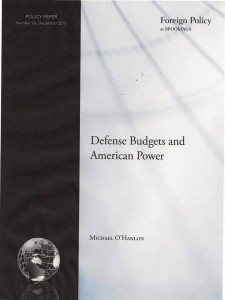
Phi Beta Iota: The author, Michael O'Hanlon, remains one of our most respected commentators on defense, and his suggestions within this document are entirely reasonable. However, he does not go far enough. A 10% reduction of a military-industrial complex budget that has nearly tripled in 30 years is not serious, nor is there innovation in this document. The military-industrial complex must be reduced by 40% if not 50%: one third direct cuts; one third reallocation to Program 150 (diplomacy & development); and one third to thinkers and actual shooters–Cyber and Advanced Information Operations, Civil Affairs, Multinational Decision Support Centres, and long over-due investment in tactical intelligence, surveillance, & reconnaissance that is Of, By, and For the Strategic Sergeant, NOT Of, By, and For Lockheed, Harris, or the U.S. Air Force.
2001 Threats, Strategy, and Force Structure: An Alternative Paradigm for National Security
2008 U.S. Naval Power in the 21st Century
2009 Perhaps We Should Have Shouted: A Twenty-Year Restrospective
2010: Human Intelligence (HUMINT) Trilogy Updated
Journal: DoD QDR–incomplete, incoherent, incredible…
Journal: Hybrid Hybrid Hybrid–Learn this Word
Journal: Pentagon Strategy & Policy Oxymoron Squared?
Journal: The Demise of Strategy in the US Government
Journal: U.S. Air Force–Remote from War & Reality
Journal: USN Refuses NGF for USMC–Gap Clearly Identified by Expeditionary Factors Study in 1989
Newt Gingrich, Vice-President for Global Engagement–Waging Peace
Reference: Debt, Deficits, & Defense–Sub-Text Bloomberg and Nunn Round Two, 52 Q&A
Reference: Frog 6 Guidance 2010-2020
Reference: Strategic Analytic Model for Creating a Prosperous World at Peace
Review: Defense Facts of Life–The Plans/Reality Mismatch
Search: QDR “four forces after next”



